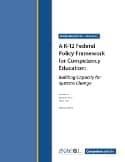A K-12 Federal Policy Framework for Competency Education
CompetencyWorks Blog
 Although there are few barriers to competency education caused from federal policy, there is certainly a lot it can do to enable and catalyze it. In A K-12 Federal Policy Framework for Competency Education: Building Capacity for Systems Change, Maria Worthen, iNACOL‘s Vice President for Federal and State Policy and Lillian Pace, KnowledgeWorks’ Senior Director of National Policy, explore the ways that federal policymakers can become partners in the effort to redesign our education system around making sure students reach proficiency every step of the way towards college and career readiness.
Although there are few barriers to competency education caused from federal policy, there is certainly a lot it can do to enable and catalyze it. In A K-12 Federal Policy Framework for Competency Education: Building Capacity for Systems Change, Maria Worthen, iNACOL‘s Vice President for Federal and State Policy and Lillian Pace, KnowledgeWorks’ Senior Director of National Policy, explore the ways that federal policymakers can become partners in the effort to redesign our education system around making sure students reach proficiency every step of the way towards college and career readiness.
Maria and Lillian emphasize that federal policymakers need to think about themselves as partners in this work as they consider ways to remove barriers to competency education, provide funding incentives, and support the development of learning infrastructure. As a starting point, federal policymakers can support state and local innovators by establishing a student-centered federal policy framework that supports competency education, with four guiding principles in mind:
Greater rigor and relevance — Measurement of student learning should be based on ensuring that students are on track and held to high, rigorous standards and aligned competencies — from cradle to career — to be successful in college and the workforce.
A shift from “one size fits all” to “fits each student” — All elements of the system, from data systems to accountability, would be built around student learning needs — not those of adults or institutions. In this system, time would be variable and learning constant, unlike our current system in which time-based policies drive most educational decisions. Students would actively engage in their learning, and educators would be prepared to adapt instruction to their needs with robust, multi-tiered supports and universal learning design.
Educator empowerment — Personalized, dynamic, and collaborative instruction would be the hallmark of a system that supports competency education. Educators’ roles would shift as they take a more active role in designing assessments and personalizing instruction to ensure that every student advances along his or her individual learning trajectory. The system would also ensure that educators have the supports, instructional tools, and content to personalize instruction and provide timely supports and interventions.
Transparency and equity — Our current accountability system hides the true extent of the achievement gap. Increased transparency and equity shift the focus to closing the achievement gap and raising the bar for each student. Individual student growth and proficiency measures can be lost in averages, n sizes, and cohorts. Assessing students when they enter a program and continuously throughout their learning trajectory is the only way to understand where students are in their learning progressions. This information can help educators understand what students need to do to demonstrate competency, and could ensure that they receive “just in time” supports and interventions to advance at an adequate pace. A system that supports competency education would expand educational opportunity for all students, regardless of their background or challenging circumstances.
The paper explores four areas that federal policymakers need to dig into if they are going to be able to ensure policies enable, not constrain, innovation.
- Accountability: Federal accountability policies should incent districts, schools, and educators to use real-time, individual student data to tailor instruction, supports, and interventions to ensure that each student is on pace to graduate with mastery of college- and career-ready standards and aligned competencies.
- Systems of Assessments: Flexible, balanced systems of assessments should measure mastery of competencies aligned to standards, with multiple measures, performance assessments, and evidence providing educators with a data-driven guide for prioritizing continuous improvement of student learning to ensure that every student is on pace to graduation.
- Supports and Interventions: The federal government should support states and districts in the development and implementation of a proactive system of supports and interventions that use real-time data to help students advance to college and career readiness through learning experiences aligned to their personalized learning pathways.
- Data Systems: Student-centered data systems should collect, report, and provide transparent information on where every student is along a learning trajectory based on demonstrating high levels of competency, to help educators customize learning experiences to ensure that every student can master standards and aligned competencies. Data should provide useful information for improving teaching and learning, as well as for accountability and quality purposes.
We consider this paper the beginning of a conversation – it’s going to take a lot of listening and learning to re-image what accountability and systems of assessments might look like in its next reiteration. We hope you’ll share your thoughts with us by comments, emails or submitting your thoughts for a blog.